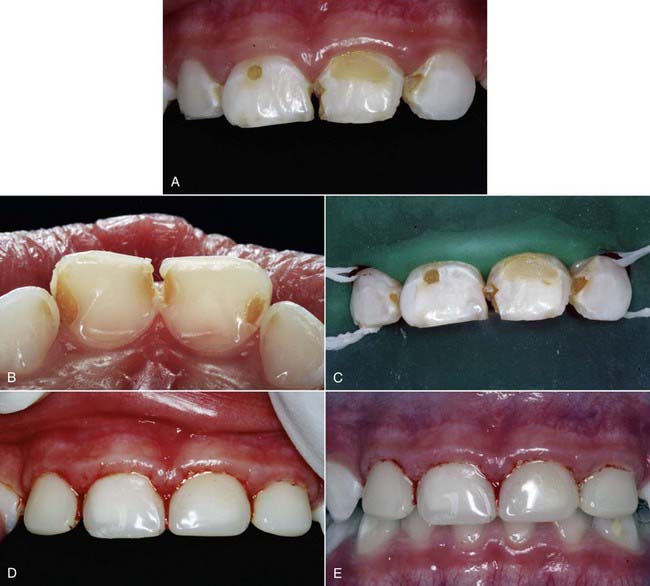Chapter 30 Pediatric Dental Procedures
Relevance to Esthetic Dentistry
Effect of Esthetically Undesirable Teeth on Child’s Self-Image, Growth, and Development
If a child loses the primary maxillary incisors prematurely, that is, before the permanent successors are erupted, he or she can have 2 or 3 years during which there is a space. The child might be made fun of in school or other social situations. Many studies show that children with crowded teeth may have low self-esteem.1,2 A main cause of crowding in the permanent dentition is space lost in the primary dentition because orthodontic treatment was not performed. If the skeletal causes of orthodontic problems are excluded, crowding in the permanent dentition most often results from the early loss of primary teeth through decay or infections. Space may also be lost without loss of the tooth when an interproximal caries lesion remains untreated. Clearly the primary dentition can have an effect on the permanent dentition and can potentially damage the child’s self-esteem.
Clinical Considerations
Primary Anterior Teeth
Treatment of Choice
Resin Composite (Strip) Crowns
Resin composite crowns are the most esthetically desirable anterior restorations for primary anterior teeth but are also among the most technique-sensitive procedures. With crowding of the anterior teeth, it is quite challenging to perform a direct composite restoration. Also, primary teeth are whiter than permanent teeth. Most of the time, shade A1 or Extra White must be used. If in doubt, a tab of composite can be placed on the tooth and light cured to account for the shade changes occurring during polymerization. Once the proper shade has been selected, the process continues using that composite. Figure 30-1 presents an example of adhesively bonded resin composite (strip) crowns.
Isolation Technique
Because placing composite is so technique sensitive, it is necessary to use rubber dam isolation to achieve a good result. Many isolation techniques have been used by clinicians. Traditionally the most popular techniques are the use of ligature ties with dental floss to retract the gingival tissue or gingivectomy with electrosurgery. A simplified technique using orthodontic elastomers was recently proposed and shown to be both efficient and effective.3
Summary—Primary Anterior Teeth
Esthetically, resin composite crowns are the best option among the other substitutes. In terms of gingival health, properly finished resin composite crowns are also better than either stainless steel crowns with window facings or veneered stainless steel crowns. However, adequate remaining tooth structure and controllable gingival hemorrhage are crucial for their success. Studies have reported high parental satisfaction with veneered stainless steel crowns.4,5 The failure of the resin facings can be problematic, and these crowns cannot be repaired easily, as opposed to resin composite crowns. The stainless steel crowns with window facings are very retentive and can be used for teeth with minimal remaining structure. The facings may be dislodged as with veneered stainless steel crowns. Owing to their time-consuming and compromised esthetics compared with other options, stainless steel crowns are not very promising for a future in which alternative and easier solutions may be available.
Stay updated, free dental videos. Join our Telegram channel

VIDEdental - Online dental courses



